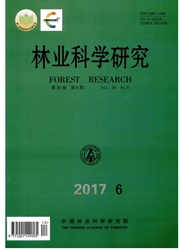

 中文摘要:
中文摘要:
通过凋落物定点收集调查和分解袋定点埋置实验,对文峪河上游山地溪流河岸带寒温性针阔叶混交林的年凋落量动态和凋落叶在不同环境中的分解进程进行了周年研究。结果表明,研究地区山地溪流河岸林在河岸带和溪流中的年凋落量分别为3.46和4.09t·hm-2·a-1;河岸带和溪流凋落物中阔叶凋落量占优势,分别占40.55%和40.19%,针阔叶凋落量分别占到总凋落量的62.00%和59.64%,枝和叶凋落量分别占总凋落量的81.09%和77.92%,凋落物各组分的比例从大到小依次为阔叶〉针叶〉枝条〉杂物〉花和果实〉树皮;河岸带和溪流的凋落量年动态均呈双峰态,其中秋季高峰期出现在9月中旬到10月中旬,高峰期凋落量分别占年凋落量的56.5%和52.7%;春季高峰期出现在4月到6月,高峰期凋落量分别占年凋落量的23.3%和30.3%。在本研究地区,凋落叶分解速率总的来说低于亚热带地区,但高于许多温带森林;凋落叶在水体中的分解速率比在河岸带林下快,分解系数为0.7129,半衰期为0.97年;而在河岸林下,距离河岸近的地方阳坡的分解速率比阴坡快,分解系数和半衰期分别为0.5319、0.4337和1.30年、1.60年;距离河岸远一些的地方阴坡的分解速率比阳坡快,分解系数和半衰期分别为0.6042、0.4401和1.15年、1.58年。
 英文摘要:
英文摘要:
By onsite forest litter survey and buried decomposition bags, investigation and study were conducted on the seasonal litter amount dynamics and decomposing processes of forest litter in different environments in cold temperate mixed forests of riparian zones upstream Wenyu River in motane area. The annual litter production of motane riparian forests to the riparian zone and the river were 3.46 and 4.09 t ~ hm -2 . a -J respectively. Of the litter in both environments, the litter from broadleaves was dominant, accounting for 40.55% and 40.19% respectively, while the leaves from conifer and broadleaves accounted for 62.00% and 59.64% of total litter respectively and the branches and leaves accounted for 81.09% and 77.92% respectively. In the composition of litter, the highest litter amount was from broad leaves, then from needle leaves, branches, miscellany, flowers and fruits, barks and herbs subsequently. The annual litter dynamic curves of both environments had two peaks, with the highest amounts oc- curred from mid-September to mid-October, accounting for 73.46% and 76. 92% of annual litter amounts respectively, and from April to June, accounting for 23.3% and 30. 3% of annual amounts respectively. In the study area, the decomposition rate of leaf litter in waterbody was lower than those in subtropical forests, but higher than that in many temperate forests. The decomposition rate of leaf litter in waterbody, which was 0. 712 9 with a half life of 0. 97a, was faster than that in humus layer under riparian forests. Under riparian forests where are close to river banks, the decomposition rates on sun slopes were faster than that on shade slopes, while the decomposition rate and a half life were 0. 531 9 and 1.30a for sun slopes and 0. 433 7 and 1.60a for shade ones. At where far to river banks, the decomposition rates on sun slopes were slower than that on shade slopes, while the decomposition rate and a half life were 0. 604 2 and 1.15a for shade slopes and 0. 440 1 and 1.58a for sun ones.
 同期刊论文项目
同期刊论文项目
 同项目期刊论文
同项目期刊论文
 期刊信息
期刊信息
